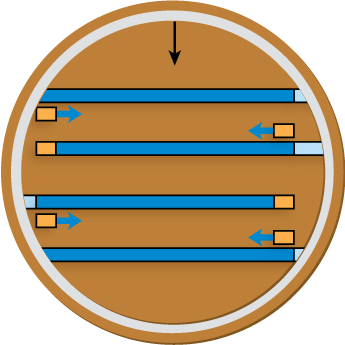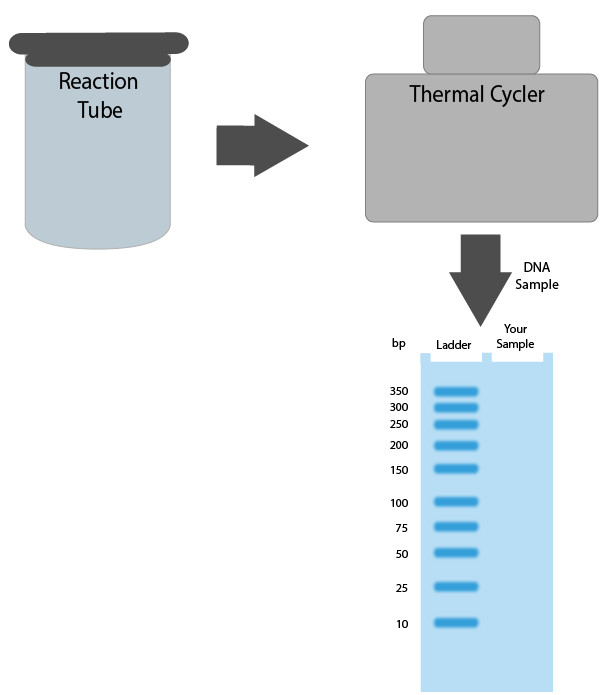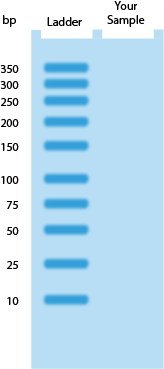
Prerequisite skills needed:
- DNA Structure and Base Pairing
- Phosphodiester Bond Formation
- Relevant book section: pages 221-223
By completing this simulation, you will:
- Understand the chemical reactions of PCR
- Carry out PCR by designing primers, mixing components, and analyzing results
- Understand how PCR is used and why it is important to a variety of fields, including the medical and criminal investigative fields
Introduction to BRCA2 and the Polymerase Chain Reaction
 Courtesy CNN
Courtesy CNN
Introduction to BRCA2 and the Polymerase Chain Reaction
PCR—Introduction to Primer Design
TGGTTTGAAGAACTTTCTTCAGAAGCTCC
ACCCT
The PCR Reaction








It’s time to set up your PCR experiment:
- Drag-and-drop the components required for PCR into the reaction tube.
- Program the three steps of the thermal cycler by selecting the correct order of events and temperatures from the drop down menus.
- Place the DNA fragment (blue gel band at right) onto the gel, at the position that would indicate your PCR generated a DNA fragment of the desired size. You may need to click back to Section 3 to review the sequence being amplified.
Incorrect - try again.
Incorrect - try again.
Incorrect - try again.
Ordering PCR Primers
TGGTTTGAAGAACTTTCTTCAGAAGCTCC
ACCCT

Enter Oligo 1:
Cost: $10
You did not include the appropriate number of nucleotides.
Your primer contains non-nucleotide letters.
Enter Oligo 2:
Cost: $10
You did not include the appropriate number of nucleotides.
Your primer contains non-nucleotide letters.
Thank you for purchasing your oligonucleotides from CDO Biotechnologies!
PCR Results


In analyzing the gel result, which of the following do you agree with?
You read the gel incorrectly.
Fortunately for your lab, your primer design was correct and your gel shows that your PCR was successful in amplifying the BRCA2 exon 3 fragment. Your advisor is very pleased (although she does wish you would get a little better at reading gels…).
Click the green button to view a simulation of the PCR you just performed.
Click the green button to view a simulation of what the PCR would have looked like, had your primer design been correct.
Click the green button to view a simulation of what the PCR would have looked like, had your primer design been correct.
Original DNA Strand:
TGGTTTGAAGAACTTTCTTCAGAAGCTCC
ACCCT
| Correct Primer: | |
| Correct Primer: |
Results
Congratulations! You read the gel correctly and designed the primers correctly, successfully amplifying the BRCA2 exon 3 fragment. Your advisor is very pleased! Click the green button to view a simulation of the PCR you just performed.Original DNA Strand:
TGGTTTGAAGAACTTTCTTCAGAAGCTCC
ACCCT
| Correct Primer: | |
| Correct Primer: |
Original DNA Strand:
TGGTTTGAAGAACTTTCTTCAGAAGCTCC
ACCCT
| Your Primer: | |
| Your Primer: | |
| Correct Primer: | |
| Correct Primer: |
Results
You read the gel correctly. Nice job! Unfortunately, your primer design was incorrect and your gel shows that your PCR did not amplify the BRCA2 exon 3 fragment. Your advisor is not thrilled with the fact that you wasted $20 and a bunch of time.Hints:
- DNA is complementary.
- The primers need to be adjacent to the target.
- DNA is directional.
- It looks like you may have accidentally entered the same oligo twice. The two primers will most likely have different sequences.
Original DNA Strand:
TGGTTTGAAGAACTTTCTTCAGAAGCTCC
ACCCT
| Your Primer: | |
| Your Primer: | |
| Correct Primer: | |
| Correct Primer: |
Results
You read the gel incorrectly. Unfortunately, your primer design was also incorrect and your gel shows that your PCR did not amplify the BRCA2 exon 3 fragment. Your advisor is not thrilled with the fact that you wasted $20 and a bunch of time.Hints:
- DNA is complementary.
- The primers need to be adjacent to the target.
- DNA is directional.
- It looks like you may have accidentally entered the same oligo twice. The two primers wil most likely have different sequences.
PCR Simulation
Now that you’ve been viewing the PCR simulation, show that you haven’t been asleep. What is the next step in this PCR? Use the selection widget below to choose.
Maybe last time was beginner’s luck. Can you bring it again? Use the selection widget below to choose the next step in this PCR.
It seems that you do know PCR! So just one more time, use the selection widget to specify the next PCR step.
We’ve just completed 4 cycles of PCR. How many DNA fragments will be present after the 5th cycle is complete? Input your answer below, and click Submit.
Correct!
Incorrect, answer is 32 or 25
Click on the Identify Mutation button below to finish the PCR activity.
BRCA2 Mutation Analysis
Exon 3 of BRCA2 Gene:
- Move the view port left or right until you see a sequence with all red letters except for one (also, the blue bar will turn red).
- Stop moving the view port, and click on the mutated base in the PCR Amplified Fragment box.